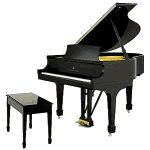

Choose the letter which begins musical term that you would like to learn about:
| A | B | C | D | E | F | G | H | I | J | K | L | M | N | O | P | Q | R | S | T | U | V | W | X | Y | Z |
CThe first note in the scale of C. The sign for common time (4/4) is not really a C but two thirds of a circle.
CadenceA chordal or melodic progression which occurs at the close of a phrase, section, or composition, giving a feeling of repose; a temporary or permanent ending. The most frequently used cadences are perfect, plagal, and deceptive. Other types of cadences are Authentic, Perfect authentic, Imperfect authentic, Half, Perfect plagal,Imperfect plagal and Phrygian.
Cadential modulationThe assumption of a new key by simply beginning on its tonic after a perfect authentic cadence in the old key.
CadenzaA solo passage, often virtuosic, usually near the end of a piece, either written by the composer or improvised by the performer.
CaesuraA sudden silencing of the sound; a pause or break, indicated by the following symbol: //
Calmo, calmatoCalm.
CambiataA direction found in scores to change tuning or instruments.
CamminandoFollowing easily and gently.
CancelAnother name for a natural sign. It is also organ stop.
CanonThe strictest form of imitation, in which two or more parts have the same melody but start at different points.
CanonicA term used to describe a polyphonic style of music in which all the parts have the same melody but which start at different times.
CantabileIn singing style.
CantataBaroque sacred or secular choral composition containing solos, duets, and choruses, with orchestral or keyboard accompaniment.
CarolThe term was derived from a medieval French word, carole, a circle dance. In England it was first associated with pagan songs celegrating the winter solstice. It then developed into a song of praise and celebration, usually for Christmas.
C clefA clef usually centered on the first line (soprano clef), third line (alto clef), fourth line (tenor clef), or third space (vocal tenor clef) of the staff. Wherever it is centered, that line or space becomes middle C.
C durKey of C major.
Chance musicAleatoric music.
ChoraleHymn-like song, characterized by blocked chords.
ChordA combination of three or more tones sounded simultaneously.
ChromaticAscending or descending by half steps.
Chromatic scaleA scale composed of 12 half steps.
Circle of fifthsThe succession of keys or chords proceeding by fifths.
ClassicalMusic conforming to certain form and structure. Usually music composed during the period 1770-1825.
ClefA symbol placed at the beginning of the staff to indicate the pitch of the notes on the staff. The most commonly used clefs in choral music are the G (treble) clefand the F or bass clef
. On the keyboard, all the notes above middle C are said to be in the G clef; all the notes below middle C in the F clef.
C molKey of C minor.
CodaClosing section of a composition. An added ending.
Col, coll', collaWith or "with the."
Common time4/4 meter.
Complete cadenceI-IV-V-I progression.
ComposerA person who creates (composes) music. Read biographies of many composers and musicians.
ConWith.
Con brioWith spirit; vigorously.
Con caloreWith warmth.
ConcertA public performance of music.
Concert grand pianoThe largest of the grand pianos, usually about nine feet long.
ConcertinoA short concerto. The group of soloists in a concerto grosso.
Concert masterFirst chair violinist in an orchestra.
ConcertoA piece for a soloist and orchestra.
Concert pitchThe international tuning pitch - currently A 440 or 442. The pitch for non-transposing (C) instruments.
ConductingThe directing of a group of musicians.
ConductorThe person who directs a group of musicians.
Con intensitaWith intensity.
ConjunctPitches on successive degrees of the scale; opposite of disjunct.
Con motoWith motion.
ConsonanceIntervallic relationships which produce sounds of repose. Frequently associated with octave, third and sixth intervals; however, fourths and fifths may be sounds of consonance, as in both early and Twentieth-century music.
ConsortA 17th-century term for instrumental chamber ensembles and for the compositions written for these ensembles.
Con spiritoWith spirit.
ContraThe octave below normal.
Corda, cordeString.
CountermelodyA vocal part which contrasts with the principal melody.
CounterpointThe technique of combining single melodic lines or parts of equal importance.
CrescendoGradually louder.
CueIndication by the conductor; or a spoken word or gesture for a performer to make an entry. Small notes that indicate another performer's part. Music occurrence in a film.
Cut time2/2 meter.

A B C D E F G H I J K L M N O P Q R S T U V W X Y Z
Some definitions and terms excerpted from
Belwin Pocket Dictionary of Music: Music Theory Dictionary
By Dr. William Lee
Students may purchase a copy for home use at cost
Many thanks to Dearest for everything!
is located
in Fairfax, Virginia
Over 30 Years
~~
Piano, Organ
Electric Keyboard
Accompanying
All rights reserved.
Site design and maintenance by
O'Connor O'Riginals Web Design
